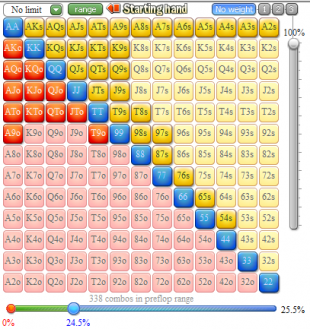So by now we all know which starting hands are good and which are bad, but there's still a ton of variables that should influence your decision to open a particular hand preflop....In this article we'll look at some important factors when deciding pre-flop opens:
i) Limitations of the Starting hand chart
ii) Position
iii) Limpers/Posters
iv) Stack-sizes
v) Open-raise size
vi) Edge/Reads
Limitations of the starting hand chart
Don't take the starting hand chart as gospel!

Many beginners are encouraged to make use of a starting hands chart (SHC)when first embarking on a poker career. While this suggestion is not without merit, it is particularly important to understand where its limitations lie.
A starting hands chart is very useful as a rough guide for an absolute beginner, but your ultimate goal should be to progress away from this as soon as possible. Poker is a dynamic game; the person who can adjust the most efficiently to the strategy of another is the one who will win the chips in the long run. Playing a static strategy in such a game is going to, at the very least, confine you to mediocrity - if not cause you to become a downright losing player.
Assuming we had a SHC representative of tight-aggressive play, let's consider some of the situations where we would typically deviate from our "standard" open-raising strategy in a 6max game.
Position

This is partially factored into most starting-hands charts. A hand like A8o should be a standard open-raise on the button in many games. A8o from UTG however, is usually going to be trash and is a standard fold.
You should also consider your position relative to other players at the table. If there are fish in the blinds you might choose to open looser from early-position, because if these players call you will have position postflop. If there are loose or aggressive players in position on you, you should often tighten up. Perhaps you are in the CO with a loose-aggressive player on the button, and as a result you should tighten up your CO opening-range.
Limpers/Posters
If there are fish who open-limp you can choose to iso-raise a lot wider when you have position. (This is not strictly an "open"-raise but similar principles apply.) Perhaps you find yourself with a hand you wouldn't normally open raise with from a specific situation, but playing that hand in position against a fish will likely still be +EV.
A similar principle applies if there are posters involved in a hand. You can often raise a little wider seeing as the extra dead-money means you don't need to steal the pot as often for it to be profitable. Posters will be folding a lot because their range pretty much includes any 2 cards. If you've already seen them check, their range becomes any 2 cards they didn't want to raise!
Stack Sizes
This is one factor that is completely disregarded in almost all SHCs, yet is a crucial piece of information in establishing which ranges you want to open.
is one factor that is completely disregarded in almost all SHCs, yet is a crucial piece of information in establishing which ranges you want to open.
If we take a very simplified view of the different starting hands we can split them into two categories. Hands which benefit from implied-odds, and hands which suffer from reverse implied-odds.
Hands which benefit from implied-odds: These typically include speculative hands like 78s. These hands don't have immediate showdown-value, yet they do have some potential to make strong nutted hands a small proportion of the time. It's important that when you do make a flush/straight/straight-flush that there is enough money in villain's stack to make it profitable in the long run. In other words, if villain has a very short stack, it can quite easily become un-profitable to play a hand like 78s.
The other type of hand, is that which suffers from reverse implied-odds: These are hands with immediate showdown value like AK, or QQ. You have no problem playing these against a shortstack because a large proportion of the time you will either be committed preflop or on the flop. They suffer from reverse implied odds because as the stacks get deeper, you are less happy with stacking off with the type of hands they make, namely big one-pair hands. If your opponent seems extremely happy to get 200BB stacks in, it's likely that your AK on the K678 is no good; whereas, if villain only has a 25BB stack, it's a snap-call with TPTK.
The hands in between:
There are some hands that fall in the middle of these two categories, such as QTs. This is both a speculative hand, and a hand that makes weak-top pairs. How you choose to play it depends on the exact circumstances. Much of the time if villain is deep, you will play it as a speculative hand, while if villain is shallow you will play it as a TPGK hand.
General rule of thumb:
As a general rule you want to tighten up your open-raises when shortstacks are still left to act. As the stacks get deeper you can start opening a lot wider with all kinds of speculative hands. (Theoretically when the stacks are super-deep, perhaps 1000bb deep, you can open 27o even if you never steal preflop, because you have sufficient implied odds. In practice you'd only ever do this if you expect to have a huge post-flop edge). You should then be careful playing TPTK/Overpair as the stacks get deeper. Playing AKo 200BB deep, it is likely you will need to employ some pot-control during the hand if you make a TPTK hand. You will also be less comfortable putting yourself in a situation where you need to stack off preflop for 200BB+, even with hands like KK where it might be standard to stack off in a 100BB pot.
Open-Raise Sizing
You should often vary your open-raise size, depending on the players at the table and the position you are opening from.
Typically many follow a strategy where they open larger from UTG, and smaller from the Button. This is partially because your UTG open-raising range is typically stronger than your BU opening range. Your UTG open also needs to get through more players, and you perhaps discourage them from calling you in-position with a slightly larger open raise size.
This is just a generic sizing strategy however, and you should consider making deviations depending on the players at the table. Perhaps you are getting relentlessly 3bet by a certain opponent; you could choose to open-raise smaller so you lose less, make 3betting less attractive for villain, and also make it easier for you to flat-call if you were so inclined.
Or perhaps villain is a huge fish, that plays every hand, but always check-folds when he misses the flop. Why not open-raise large, perhaps 5x or 6x and take it down on the flop? Perhaps villain NEVER folds anything preflop, and you have AA, why not raise to 10x or even more?
Conversely perhaps you are UTG with a suited-connector, and you know that regardless of your raise sizing, you are likely getting called in several spots. So why not open-raise smaller?
Edge/Reads
A big factor in which ranges you choose to open also depends on any reads you have and also how big your edge is.
It's often going to be wise to discard any marginal opens if the table is very tough. Certain hands like Axs which you can potentially open UTG in some games, perhaps become standard folds in games where you are going to exploited too heavily by smart opponents with position.
Certain reads may cause you to open tighter/loser, or may also cause you to open slightly different ranges. If you know villain is a postflop calling station, you might want to tighten up your open-ranges. If you know villain will play fit-or-fold on every flop, you can sometimes loosen up quite dramatically.
Perhaps you know villain is 3betting very wide, and then open a certain type of hand with the intention of 4bet-bluffing because it contains certain blockers. The further you can plan a hand before you've even open-raised, the more specific you can be about which ranges you want to open.
Summary
While SHC's may be useful tools from a theoretical perspective, and for the use of beginners, there are many aspects of a real poker game that are simply not taken into account, such as stack-sizes and relative position.
In general, the deeper the stack-sizes, the less useful a SHC becomes. A SHC certainly carries a little more relevance when applied to short-stacked play, purely because it is a little easier to say how close a play is to the mathematical optimum, but there are still deviations that could be made depending on who is at the table amongst other factors.


